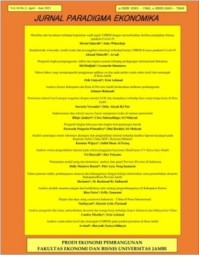Pendekatan internet marketing: strategi pengembangan industri kecil menengah kerajinan
DOI:
https://doi.org/10.22437/jpe.v16i3.14343Kata Kunci:
Internet marketing, Development strategy, IKM craftsAbstrak
This study aimed to determine the obstacles handicraft SMEs face in business development and to analyze the development strategy of small and medium handicraft industries with an internet approach. The sample of this research is Handicraft IKM entrepreneurs in districts/cities in Jambi Province. The data collection tool is in interview guides with both craft IKM actors and critical respondents. The types of data required are primary data and secondary data. Preliminary data were collected utilizing interviews and direct observation of SMI actors, while secondary data was obtained from literature and reports from related institutions. The data and information obtained are processed using qualitative data processing methods, then further analyzed to develop priorities for the company. The analytical tools used are Internal Analysis, SWOT Matrix. The results of the study concluded that the craft IKM development strategy with an internet marketing approach could be done by: 1) marketing through the internet in the form of websites, social media (Facebook, Twitter, Instagram), and marketplace; 2) excellent service; 3) simplify the administrative process; 4) create easy hints; 5) Provide affordable fees; 6) Immediately respond to complaints and complaints.
Â
Unduhan
Referensi
Berthon, P., Holbrook, M. B., Hulbert, J. M., & Pitt, L. F. (2011). Brand manifold: Managing the temporal and socio-cultural dimensions of brands. In M. Uncles (Ed.), Perspectives on brand management (pp. 40-60). Prahran, Tilde University Press: Australia
Coughlan, A. T., Anderson, E., Stern, L. W., & El-Ansary, A. I. (2012). Canais de marketing. São Paulo: Person. Northwestern University: Evanston
Creswell, J. W., & Clark, V. L. P. (2017). Designing and conducting mixed methods research. Sage publications.
Dewanti, I. S. (2010). Pemberdayaan usaha kecil dan mikro: kendala dan alternatif solusinya. Jurnal Administrasi Bisnis, 6(2), 1-10.
Glynn, C. J., Huge, M. E., & Hoffman, L. H. (2012). All the news that’s fit to post: A profile of news use on social networking sites. Computers in Human Behavior, 28(1), 113-119.
Gürel, E., & Tat, M. (2017). SWOT analysis: a theoretical review. Journal of International Social Research, 10(51).
Hameed, M. A., Counsell, S., & Swift, S. (2012). A meta-analysis of relationships between organizational characteristics and IT innovation adoption in organizations. Information & management, 49(5), 218-232.
Heding, T., Knudtzen, C. F., & Bjerre, M. (2015). Brand management: Research, theory and practice. Routledge: United Kingdom.
Kapferer, J. N. (2012). The new strategic brand management: Advanced insights and strategic thinking. Kogan page publishers. Global Edition, 5th Edition. Kevin Lane Keller, Dartmouth College.
Kementrian Pariwisata dan Eknomi Kreatif, 2015, Kekuatan Baru Indonesia Menuju 2025.
Kannan, P. K. (2017). Digital marketing: A framework, review and research agenda. International Journal of Research in Marketing, 34(1), 22-45.
Kotler, P., Keller, K. L., Ang, S. H., Tan, C. T., & Leong, S. M. (2018). Marketing management: an Asian perspective. Pearson.
Malik, Z. (2013). Ekonomika Industri Indonesia Menuju Negara Industri Baru (2030). Andi. Yogyakarta: Yogyakarta:
Peraturan Menteri Perindustrian Republik Indonesia Nomor 64/M-IND/PER/7/2016 Tentang Besaran Jumlah Tenaga Kerja dan Nilai Investasi.
Sagan, C., dan Leighton, T. (2010). The Internet and The Future of News. American Study of Arts and Sciences 139.2 (2010): 119-125.
Sevilla, C. (2013). Pengantar Metode Penelitian.: Universitas Indonesia: Jakarta
Terrell, S. R. (2012). Mixed-methods research methodologies. Qualitative report, 17(1), 254-280
Undang-undang Nomor 20 Tahun (2008) Tentang UMKM. Sekretariat Negara. Jakarta:. Strategi pengembangan industri kecil menengah menuju industri kecil menengah kreatif di Provinsi Jambi,
##submission.downloads##
Diterbitkan
Cara Mengutip
Terbitan
Bagian
Lisensi
Hak Cipta (c) 2021 Dahmiri Dahmiri, Sylvia Kartika Wulan Bhayangkari, Wiwik Tiswiyanti

Artikel ini berlisensiCreative Commons Attribution-ShareAlike 4.0 International License.









